Modeling Uniaxial Bond Stress–Slip Behavior of Reinforcing Bars Embedded in Concrete with Different Strengths
Abstract
1. Introduction
2. Experimental Details
2.1. Materials and Mix Proportions
2.2. Proportions Casting of Specimens
2.3. Instrumentation and Test Procedures
2.4. Analytical of Measurements
2.4.1. Definition of the Model
2.4.2. Stress and Strain of Steel
2.4.3. Stress and Strain of Concrete
2.4.4. Bond Stress
2.4.5. Slip between Concrete and Steel Bar
3. Experimental Results and Discussion
3.1. Mechanical Properties of Concrete
3.2. Steel Strain Distribution
3.3. Concrete Strain Distribution
3.4. Bond Stress Distribution
3.5. Slip Distribution
3.6. Bond Stress–Slip Relationship
3.7. Position Function
3.8. Bond Stress–Slip Constitutive Relationship
4. Conclusions
Author Contributions
Funding
Acknowledgments
Conflicts of Interest
References
- Darwin, D.; Dolan, C.W.; Nilson, A.H. Design of Concrete Structures, 4th ed.; McGraw-Hill Education, 2 Penn Plaza: New York, NY, USA, 2016. [Google Scholar]
- Chu, S.H.; Kwan, A.K.H. A new bond model for reinforcing bars in steel fibre reinforced concrete. Cem. Concr. Compos. 2019, 104, 103405. [Google Scholar] [CrossRef]
- ACI Committee 408-03. Bond and Development of Straight Reinforcing Bars in Tension (ACI 408R-03); American Concrete Institute: Farmington Hills, MI, USA, 2003. [Google Scholar]
- Filippou, F.C.; Popov, E.P.; Bertero, V.V. Modeling of R/C joints under cyclic excitations. J. Struct. Eng. 1983, 109, 2666–2684. [Google Scholar] [CrossRef]
- Saeed, M.N. Internal measurement of bond stress slip relationship in reinforced concrete. Aci. J. 1979, 76, 19. [Google Scholar]
- Hong, S.; Park, S.K. Uniaxial Bond Stress-Slip Relationship of Reinforcing Bars in Concrete. Adv. Mater. Sci. Eng. 2012, 328570. [Google Scholar] [CrossRef]
- Eligehausen, R.; Popov, E.P.; Bertero, V.V. Local Bond Stress-Slip Relationships of Deformed Bars under Generalized Excitations. Report UCB/EERC-83/23; University of California: Berkeley, CA, USA, 1983. [Google Scholar]
- Zhao, J.; Sritharan, S. Modeling of strain penetration effects in fiber-based analysis of reinforced concrete structures. ACI Struct. J. 2007, 104, 133–141. [Google Scholar]
- Yu, J.; Tan, K.H. Bar stress-slip relationship in reinforced concrete joints with large inelastic bar strains. In Proceedings of the International Conference of Design and Analysis of Protective Structures, JeJu, Korea, 19 June 2012. [Google Scholar]
- Zheng, S.; Pei, P.; Zhang, Y.; Dong, L.; Zheng, J.; Dong, F. Review of Research on Bond-Slip of Reinforced Concrete. Mater. Rev. A: Rev. Pap. 2018, 32, 4182–4191. (In Chinese) [Google Scholar]
- Shima, H.; Chou, L.L.; Okamura, H. Micro and macro models for bond in reinforced concrete. J. Fac. Eng. 1987, 39, 133–194. [Google Scholar]
- Liang, X.; Sritharan, S. An investigation of the bond-slip behavior of reinforcing steel subjected to inelastic strains. In Proceedings of the Tenth US National Conference on Earthquake Engineering Fronties of Earthquake Engineering, Anchorage, AK, USA, 21–25 July 2014; p. 12. [Google Scholar]
- Cui, Y.; Zhang, P.; Bao, J. Bond Stress between Steel-Reinforced Bars and Fly Ash-Based Geopolymer Concrete. Adv. Mater. Sci. Eng. 2020, 9812526. [Google Scholar] [CrossRef]
- Huang, L.; Xu, L.; Chi, Y.; Deng, F.; Zhang, A. Bond strength of deformed bar embedded in steel-polypropylene hybrid fiber reinforced concrete. Constr. Build. Mater. 2019, 218, 176–192. [Google Scholar] [CrossRef]
- Romanazzi, V.; Leone, M.; Tondolo, F.; Fantilli, A.P.; Aiello, M.A. Bond strength of rubberized concrete with deformed steel bar. Constr. Build. Mater. 2020, 272. [Google Scholar] [CrossRef]
- Gao, D.; Yan, H.; Fang, D.; Yang, L. Bond strength and prediction model for deformed bar embedded in hybrid fiber reinforced recycled aggregate concrete. Constr. Build. Mater. 2020, 265. [Google Scholar] [CrossRef]
- Rockson, C.; Tamanna, K.; Alam, M.S.; Rteil, A. Effect of cover on bond strength of structural concrete using commercially produced recycled coarse and fine aggregates. Constr. Build. Mater. 2020, 255. [Google Scholar] [CrossRef]
- Morris, G.J. Experimental Evaluation of Local Bond Behaviour of Deformed Reinforcing Bars in Concrete Structures; University of Canterbury: Christchurch, New Zealand, 2015. [Google Scholar]
- CEB. CEB-FIP Model Code 2010; Fédération Internationale du Béton (fib): Lausanne, Switzerland, 2010. [Google Scholar]
- Huang, Z.; Engström, B.; Magnusson, J. Experimental Investigation of the Bond and Anchorage Behaviour of Deformed Bars in High Strength Concrete; Report 95:4; Chalmers University of Technology: Gothenburg, Sweden, 1996. [Google Scholar]
- Harajli, M.H.; Hout, M.; Jalkh, W. Local bond stress–slip behaviour of reinforcing bars embedded in plain and fiber concrete. ACI Mater. J. 1995, 92, 343–353. [Google Scholar]
- Harajli, M.H. Numerical bond analysis using experimentally derived local bond laws: A powerful method for evaluating the bond strength of steel bars. J. Struct. Eng. 2007, 133, 695–705. [Google Scholar] [CrossRef]
- Viwathanatepa, S.; Popov, E.P.; Bertero, V.V. Effects of Generalised Loadings on Bond of Reinforcing Bars Embedded in Concrete blocks, Report UCB/EERC-79/22; Earthquake Engineering Research Centre, University of California: Berkeley, CA, USA, 1979. [Google Scholar]
- Hawkins, N.M.; Lin, I.J.; Jeang, F.L. Local Bond Strength of Concrete for Cyclic Reversed Loadings; Bond in concrete; Applied Science Publishers: London, UK, 1982; pp. 151–161. [Google Scholar]
- Vos, E.; Reinhardt, H.W. Influence of loading rate on bond behaviour of reinforcing steel and prestressing strands. RILEM Mater. Struct. 1982, 15, 3–10. [Google Scholar] [CrossRef]
- Fang, C.; Gylltoft, K.; Lundgren, K.; Plos, M. Effect of corrosion on bond in reinforced concrete under cyclic loading. Cem. Concr. Res. 2006, 36, 548–555. [Google Scholar] [CrossRef]
- Kivell, A. Effects of Bond Deterioration Due to Corrosion on Seismic Performance of Reinforced Concrete Structures. Master’s Thesis, University of Canterbury, Christchurch, New Zealand, 2011. [Google Scholar]
- Araujo, D.L.; Danin, A.R.; Melo, M.B.; Rodrigues, P.F. Influence of steel fibres on the reinforcement bond of straight steel bars. Ibracon Struct. Mater. J. 2013, 6, 307–338. [Google Scholar]
- Choi, E.S.; Lee, J.W.; Kim, S.J.; Kwark, J.W. A Study on the Bond Strength between High Performance Concrete and Reinforcing Bar. Engineering 2015, 7, 373–378. [Google Scholar] [CrossRef]
- Pishro, A.A.; Feng, X. Experimental Study on Bond Stress between Ultra High Performance Concrete and Steel Reinforcement. Civ. Eng. J. 2017, 3, 1235–1246. [Google Scholar] [CrossRef]
- Guizani, L.; Chaallal, O.; Mousavi, S.S. Local bond stress-slip model for R/C joints and anchorages with moderate confinement. Can. J. Civ. Eng. 2017, 44, 201–211. [Google Scholar] [CrossRef]
- Marti, P.; Alvarez, M.; Kaufmann, W.; Sigrist, V. Tension chord model for structural concrete. Struct. Eng. Int. 1998, 8, 287–298. [Google Scholar] [CrossRef]
- Lowes, L.N.; Moehle, J.P.; Govindjee, S. Concrete-steel bond model for use infinite element modeling of reinforced concrete structures. ACI Struct. J. 2004, 101, 501–511. [Google Scholar]
- Fernández Ruiz, M.; Muttoni, A.; Gambarova, P.G. Analytical modeling of the pre- and post-yield behaviour of bond in reinforced concrete. ASCE J. Struct. Eng. 2007, 133, 1364–1372. [Google Scholar] [CrossRef]
- Aslani, F.; Samali, B. Predicting the bond between concrete and reinforcing steel at elevated temperatures. Struct. Eng. Mech. 2013, 48, 643–660. [Google Scholar] [CrossRef]
- Lundgren, K.; Gylltoft, K. Model for the bond between concrete and reinforcement. Mag. Concr. Res. 2000, 52, 53–63. [Google Scholar] [CrossRef]
- Dehestani, M.; Mousavi, S.S. Modified steel bar model incorporating bond-slip effects for embedded element method. Constr. Build. Mater. 2015, 81, 284–290. [Google Scholar] [CrossRef]
- Xu, Y.L. A simplified model of bond-slip relationship for reinforced concrete. Eng. Mech. A02 1997, 14, 34–38. (In Chinese) [Google Scholar]
- Tassios, T.P.; Yannopoulos, P.J. Analytical studies on reinforced concrete members under cyclic loading based on bond stress-slip relationships. J. Am. Concr. Inst. 1981, 78, 206–216. [Google Scholar]
- Somayaji, S.; Shah, S.P. Bond stress versus slip relationship and cracking response of tension members. J. Am. Concr. Inst. 1981, 78, 217–225. [Google Scholar]
- ASTM C150/C150M-15. Standard Specification for Portland Cement; ASTM International: West Conshohocken, PA, USA, 2015; Available online: www.astm.org (accessed on 15 May 2020).
- ASTM C33/C33M-13. Standard Specification for Concrete Aggregates; ASTM International: West Conshohocken, PA, USA, 2013; Available online: www.astm.org (accessed on 15 May 2020).
- Kankam, C.K. Relationship of bond stress, steel stress and slip in reinforced concrete. J. Struct. Eng. 1997, 123, 79–85. [Google Scholar] [CrossRef]
- Zhao, Y.; Lin, H.; Wu, K.; Jin, W. Bond behaviour of normal/recycled concrete and corroded steel bars. Constr. Build. Mater. 2013, 48, 348–359. [Google Scholar] [CrossRef]
- F’ed´eration Internationale du b´eton (FIB). Bond of Reinforcement in Concrete, State-of-Art Report. F´ed´eration Internationale du b´eton; International Federation for Structural Concrete: Lausanne, Switzerland, 2000. [Google Scholar]
- El-Hacha, R.; El-Agroudy, H.; Rizkalla, S. Bond Characteristics of High-Strength Steel Reinforcement. ACI Struct. J. 2006, 103, 771–782. [Google Scholar]
- Hong, S.N.; Park, J.M.; Kim, T.W.; Han, K.B.; Park, S.K.; Ko, W.J. Bond stress-slip relationship in reinforced concrete: New relationship and comparative study. In Proceedings of the 33rd Conference on Our World in Concrete & Structures, Singapore, 25–27 August 2008. [Google Scholar]
- Tang, C.W.; Cheng, C.K. Modeling Local Bond Stress-Slip Relationships of Reinforcing Bars Embedded in Concrete with Different Strengths. Materials 2020, 3, 3701. [Google Scholar] [CrossRef] [PubMed]
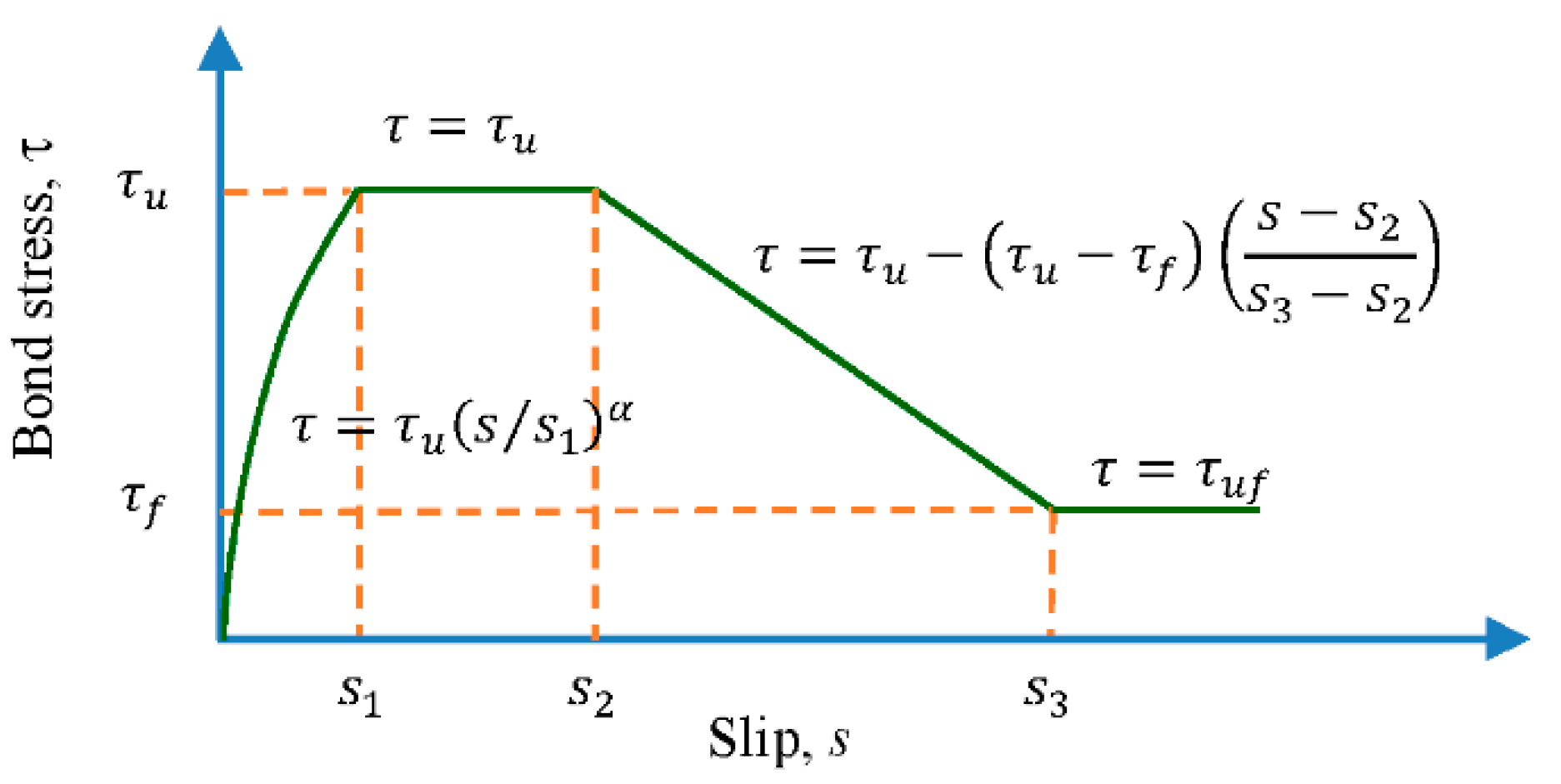
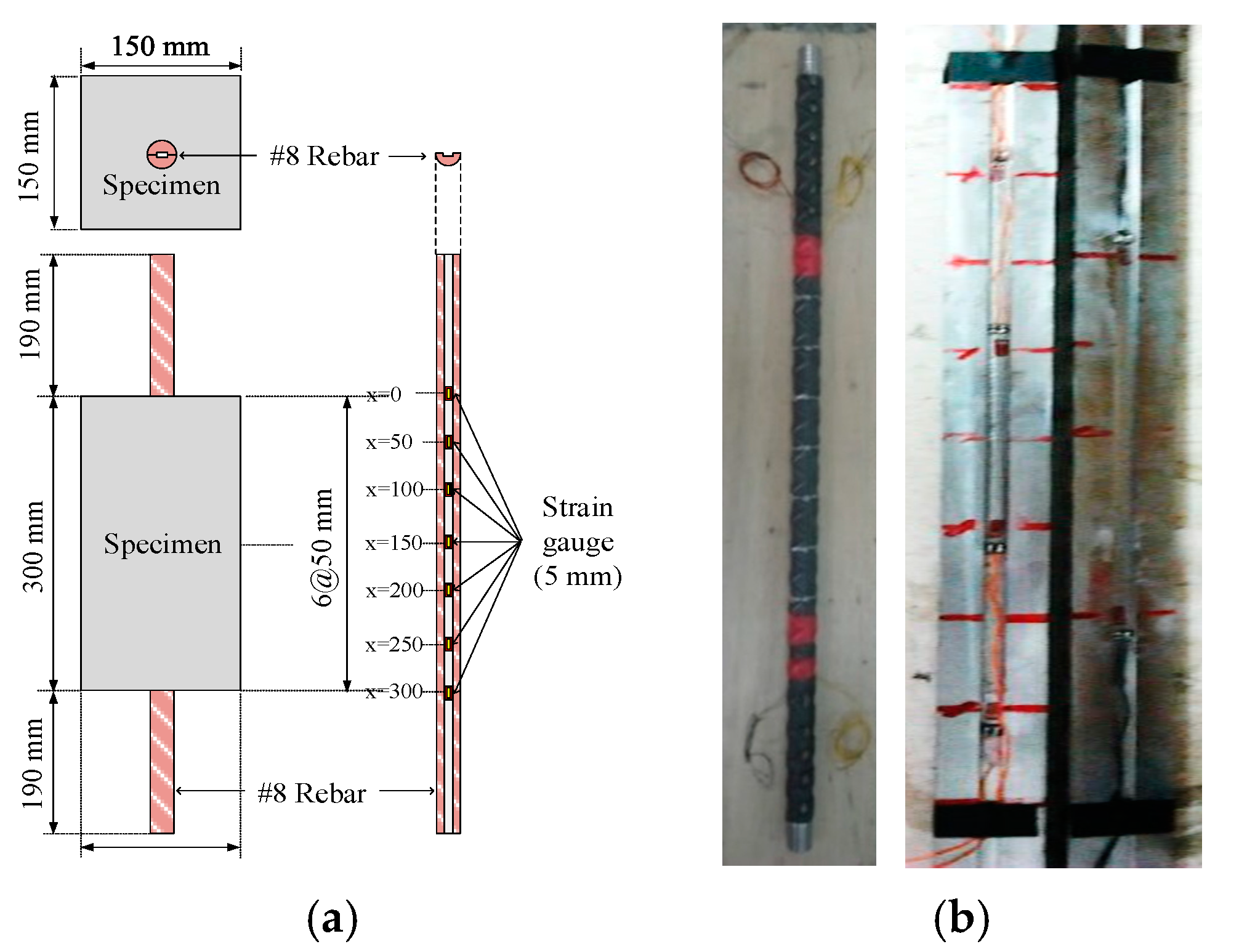
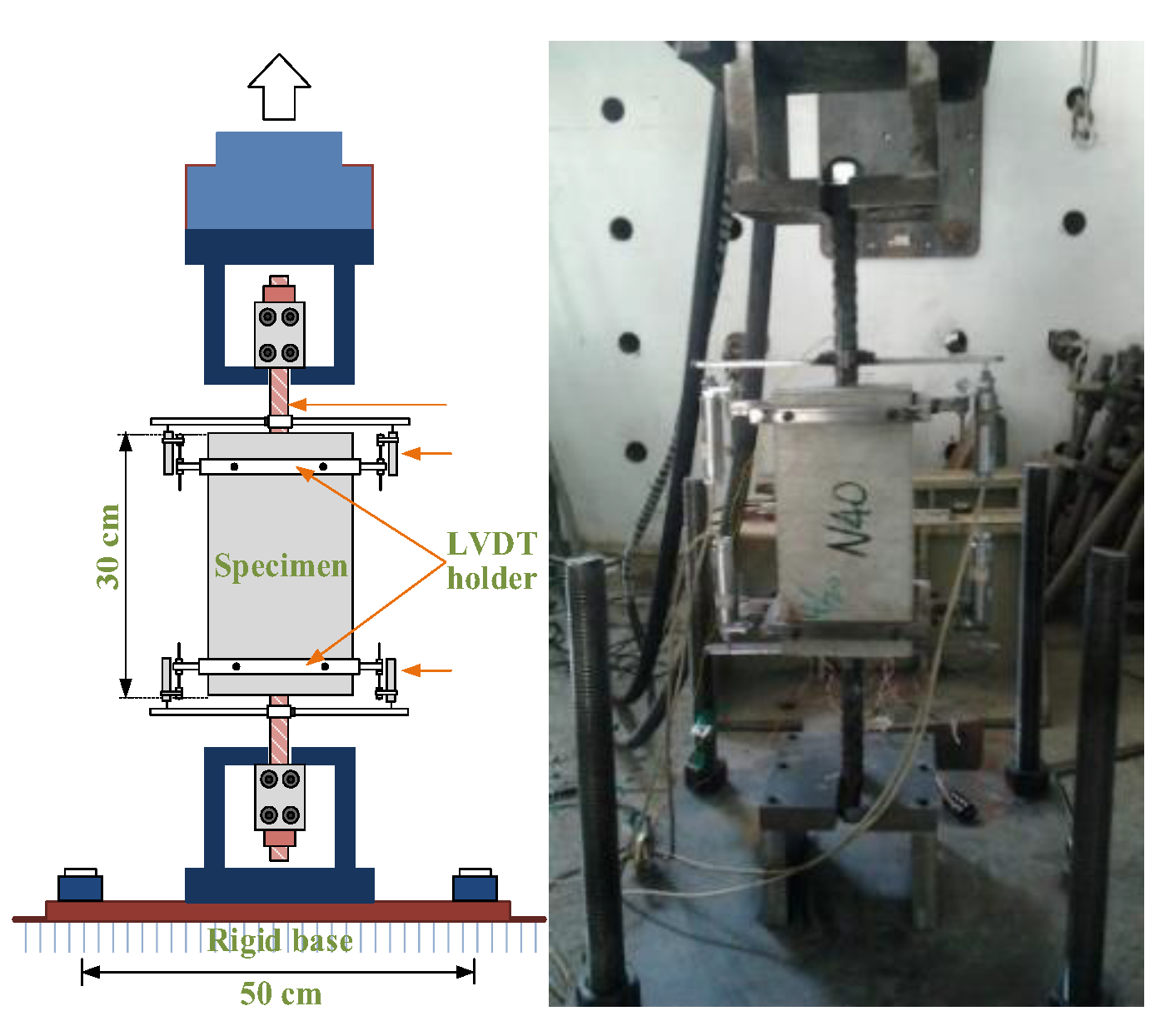

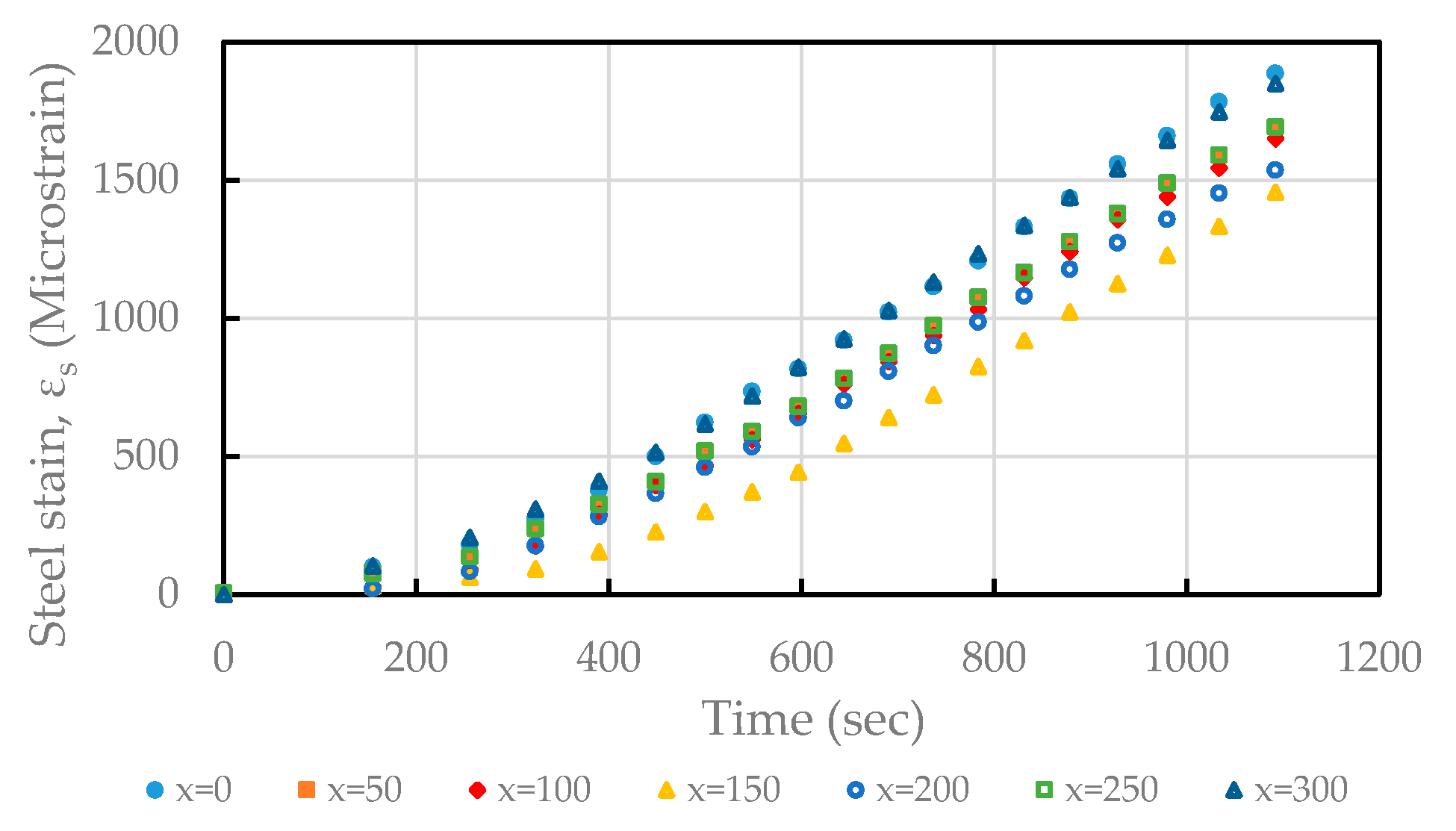
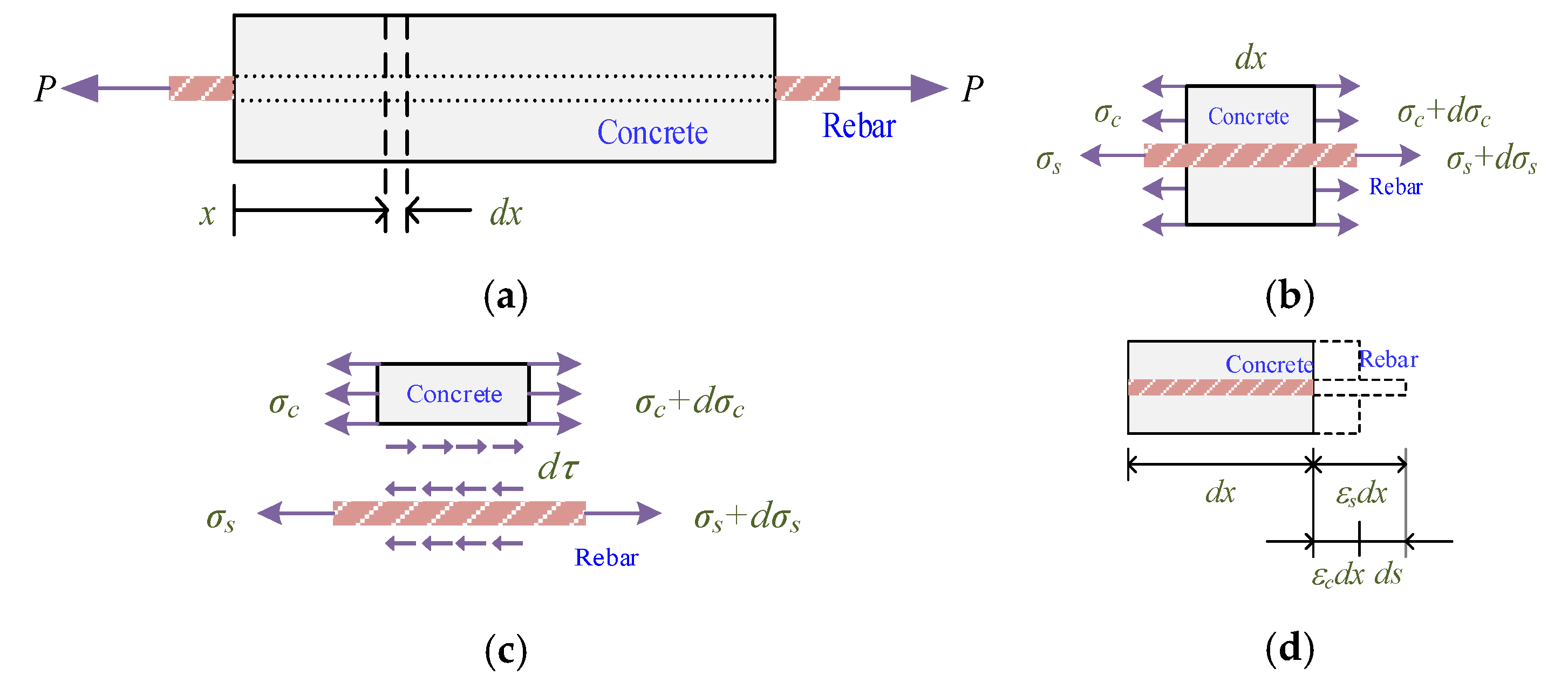

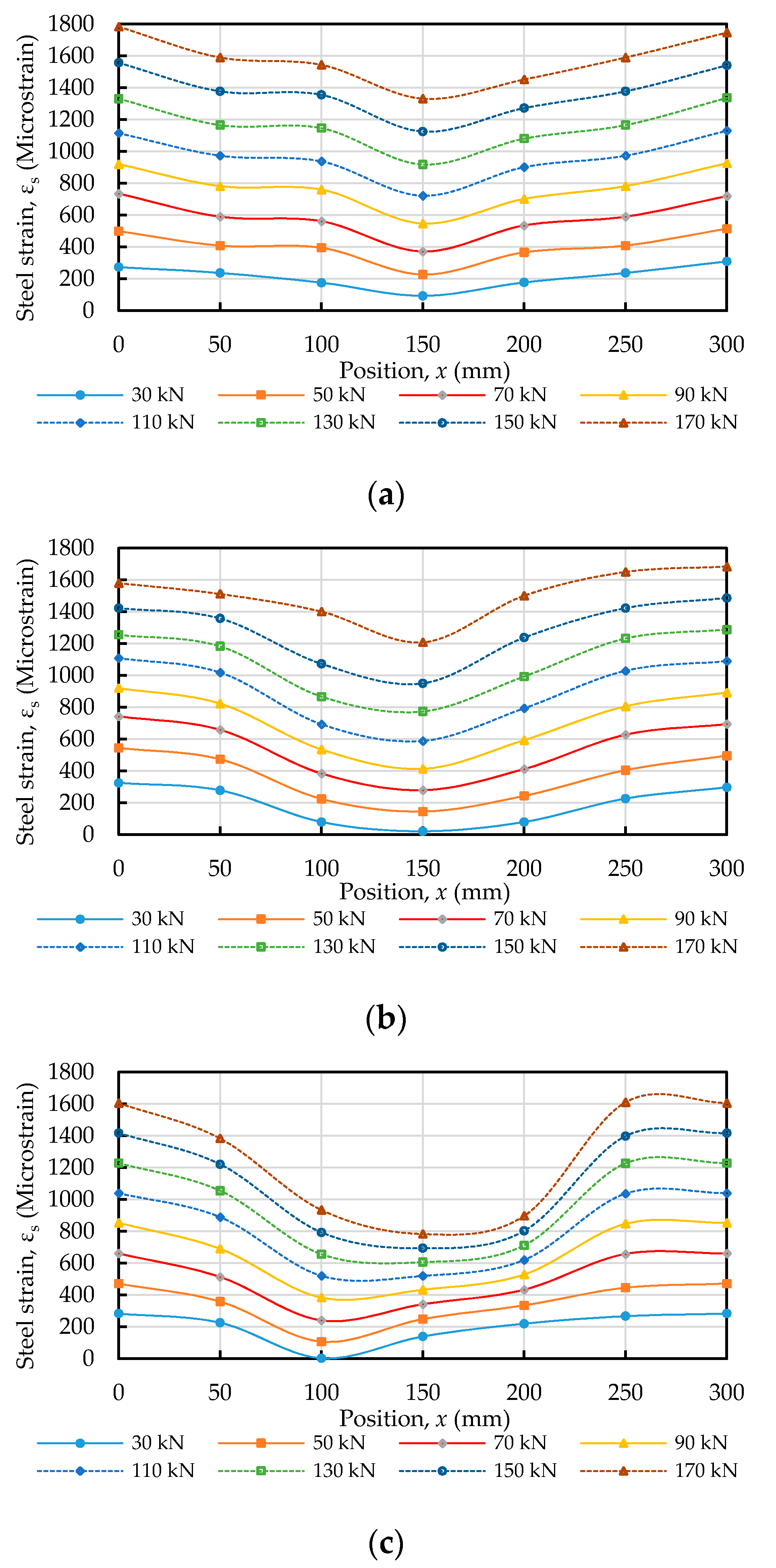
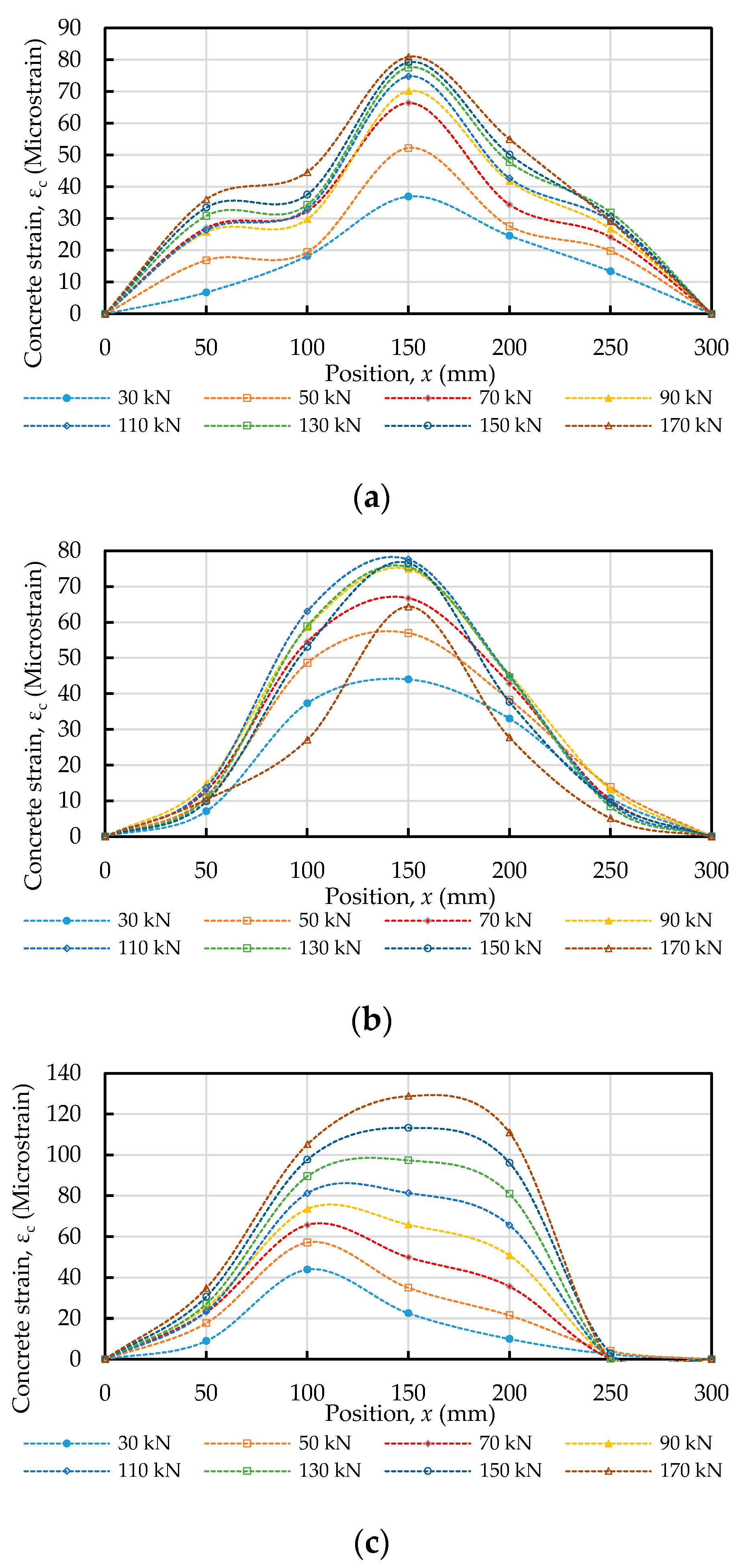
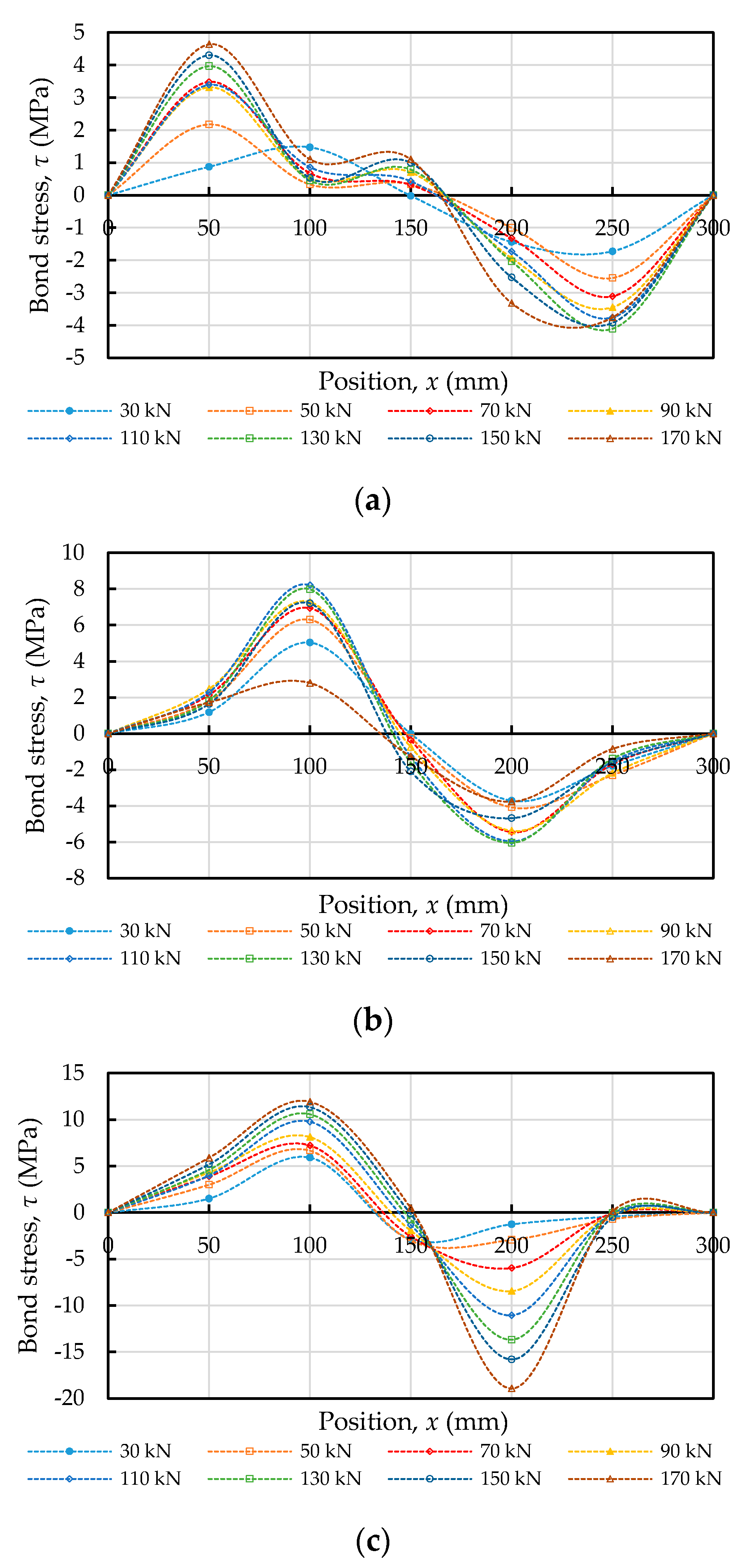
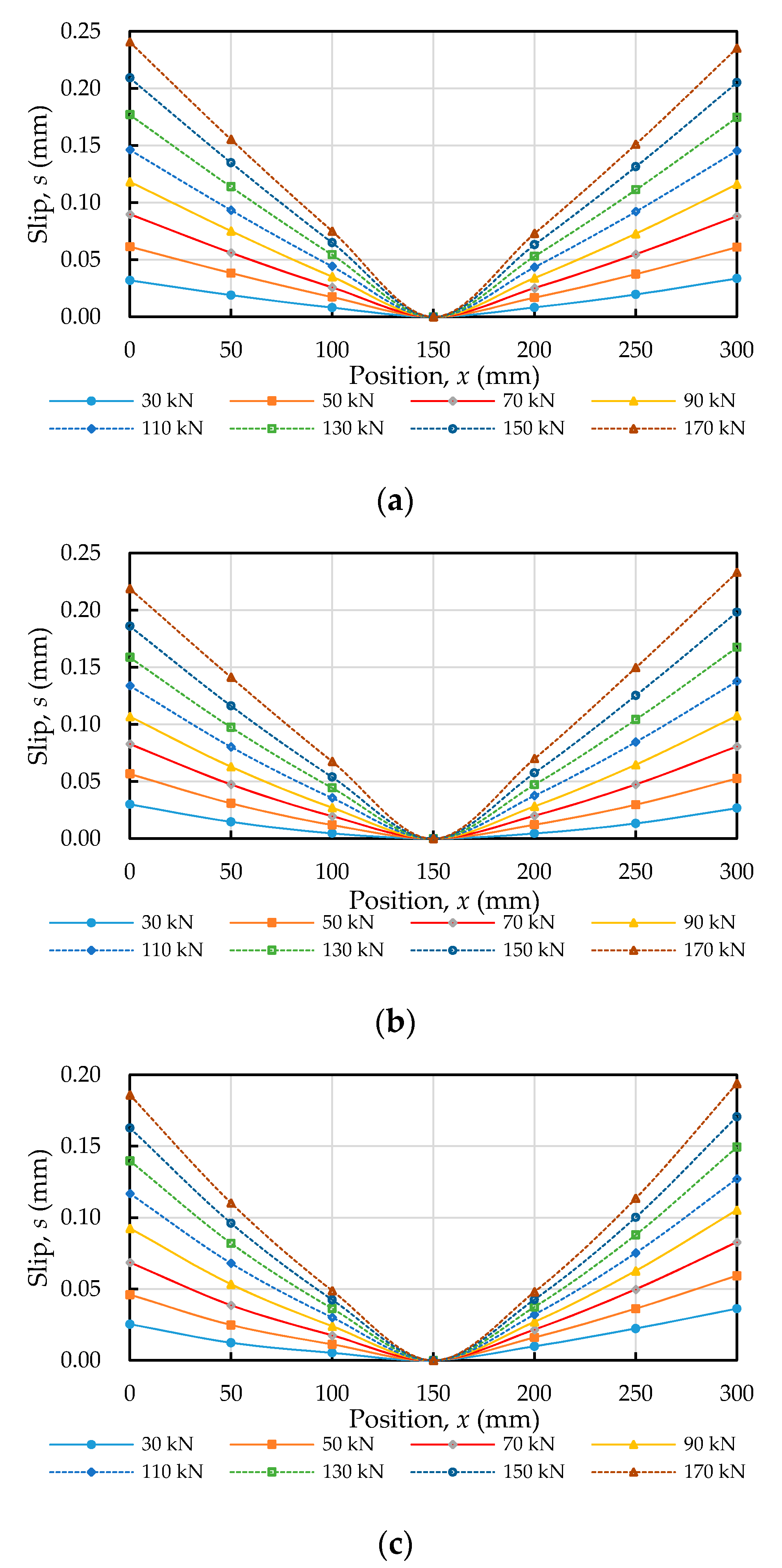
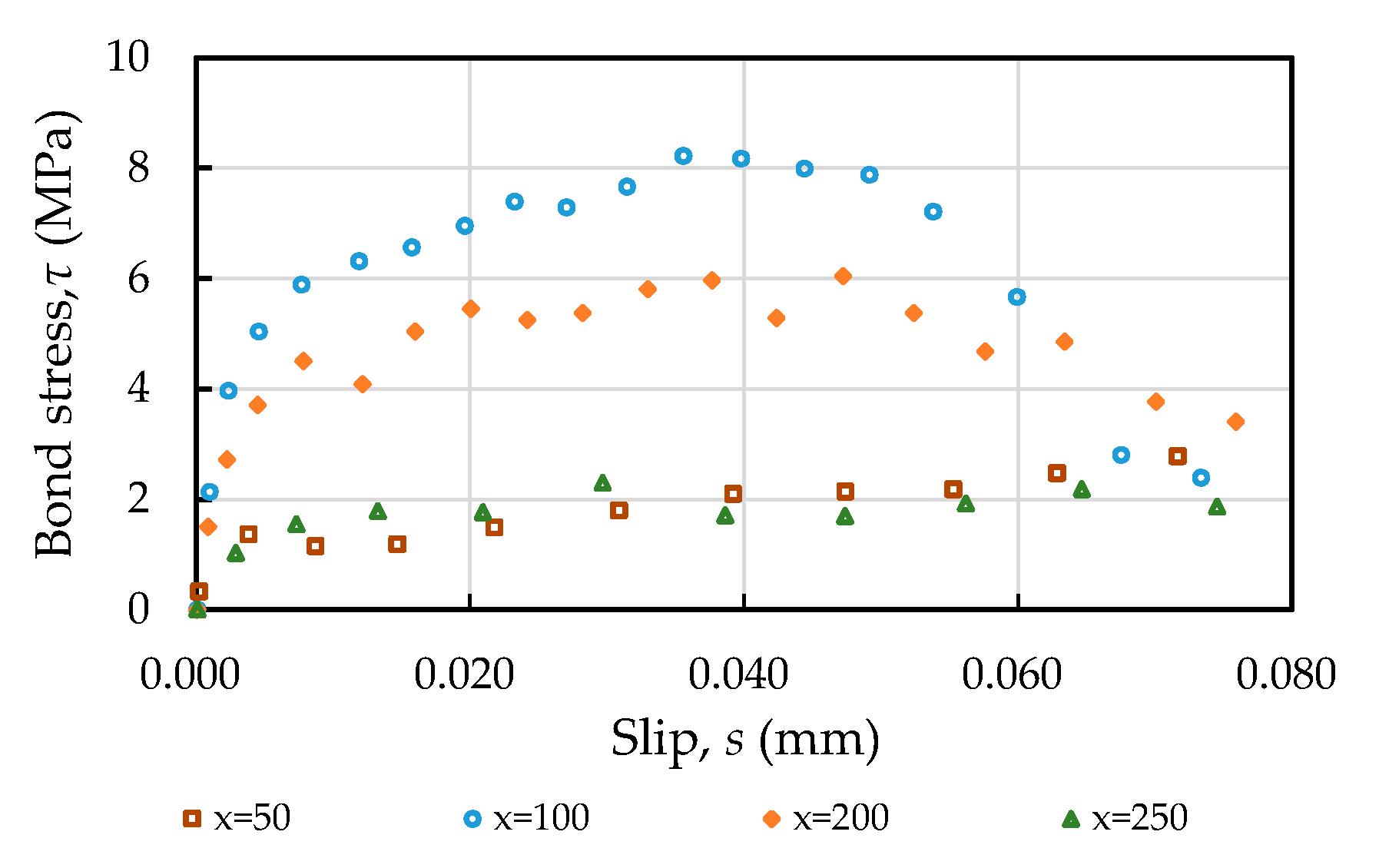
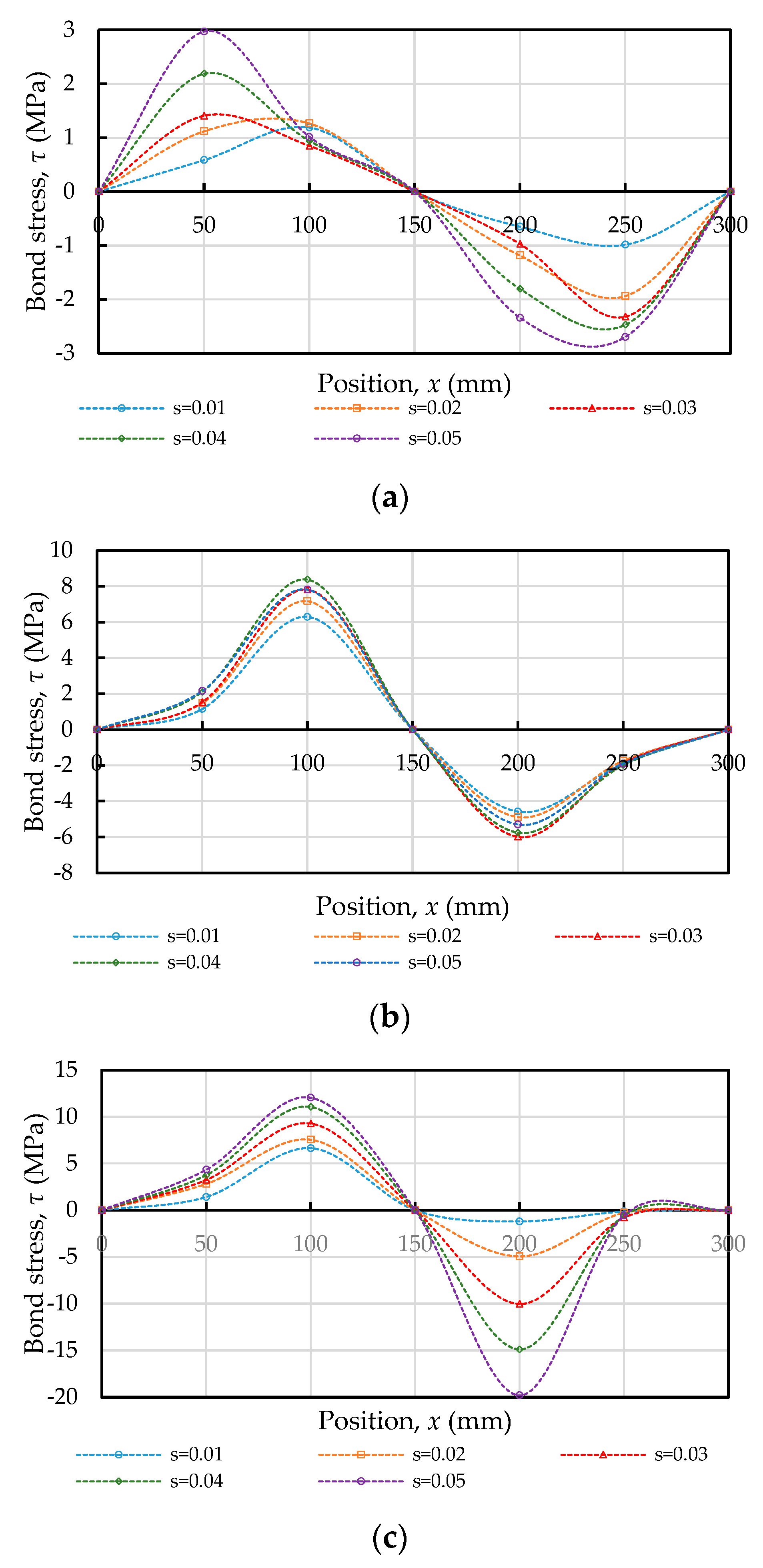
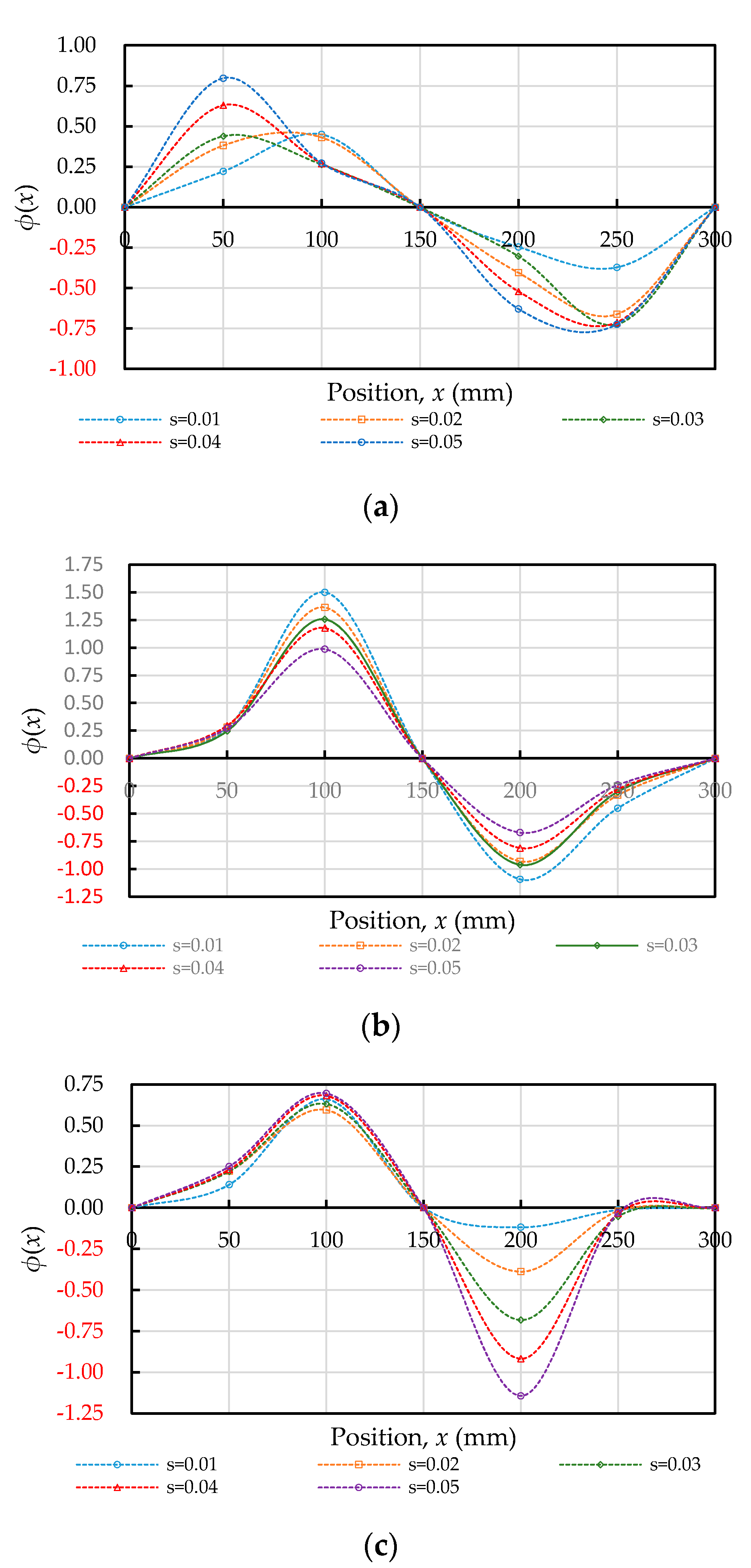

| Parameter | Model Code 2010 [19] | Huang et al. [20] | Harajli et al. [21] |
|---|---|---|---|
| Confined Concrete | Normal Strength Concrete | Concrete | |
| 1.0 mm | 1.0 mm | 0.15 Distance bet. ribs | |
| 3.0 mm | 3.0 mm | 0.35 Distance bet. ribs | |
| Distance bet. ribs | Distance bet. ribs | Distance bet. ribs | |
| α | 0.4 | 0.4 | 0.3 |
| 0.4 | 0.4 |
| Author | Concrete Type | Concrete Strength (MPa) | Embedment Length | Maximum Bond Strength (MPa) |
|---|---|---|---|---|
| Viwathanatepa et al. (1979) [23] | Normal concrete | 30 | - | 15 () |
| Hawkins et al. (1982) [24] | Normal concrete | 45 | 2db | 34 () |
| Vos and Reinhardt (1982) [25] | Normal concrete | 20 | 3db | 8 () |
| 35 | 17 () | |||
| 45 | 25 () | |||
| Eligehausen et al. (1983) [7] | Normal concrete | 30 | 5db | 14 () |
| 55 | 19 () | |||
| Fang et al. (2006) [26] | Normal concrete | 22–43 | 4db | 22 () |
| Kivell et al. (2011) [27] | Normal concrete | 65 | 4db | 32 () |
| Araujo et al. (2013) [28] | Fiber concrete | 60 | 5db | 20 () |
| Choi et al. (2015) [29] | High performance concrete | 40 | 4db | 35.9 () |
| 80 | 37.1 () | |||
| 100 | 35.3 () | |||
| 120 | 36.4 () | |||
| Pishro and Feng (2017) [30] | Ultra high performance concrete | 82.6 | 2db | 17.7 () |
| 93.6 | 19.2 () | |||
| 107.6 | 25.1 () | |||
| 113.6 | 27.0 () | |||
| Chu and Kwan (2019) [2] | Fiber concrete | 51.6–61.3 | 4.2db | 19.4–27.1 () |
| Aggregate Type | Specific Weight (SSD) | Water Absorption (SSD) (%) | Unit Weight (Dry-Rodded) (kg/m3) | FM |
|---|---|---|---|---|
| Coarse aggregate | 2.63 | 1.24 | 1532 | - |
| Fine aggregate | 2.56 | 1.33 | - | 2.75 |
| Type | Specific Weight | pH Value | Solid Composition (%) |
|---|---|---|---|
| HPC 1000 | 1.20 | 7 ± 1 | 3.37 |
| MTP A40 | 1.13 | 7 ± 1 | - |
| Mix No. | Water/Cement Ratio (W/C) | Cement (kg/m3) | Water (kg/m3) | Aggregate (kg/m3) | SP (kg/m3) | Dry Unit Weight (kg/m3) | |
|---|---|---|---|---|---|---|---|
| FA | CA | ||||||
| C20 | 0.76 | 267 | 203 | 772 | 1054 | 0 | 2147 |
| C40 | 0.52 | 390 | 203 | 670 | 1054 | 0.78 | 2194 |
| C60 | 0.32 | 591 | 189 | 523 | 1063 | 6.50 | 2301 |
| Mix No. | Compressive Strength (MPa) | Splitting Strength (MPa) | Elastic Modulus (GPa) |
|---|---|---|---|
| C20 | 20.20 | 2.40 | 23.32 |
| C40 | 40.97 | 2.91 | 30.22 |
| C60 | 59.46 | 3.23 | 30.72 |
Publisher’s Note: MDPI stays neutral with regard to jurisdictional claims in published maps and institutional affiliations. |
© 2021 by the author. Licensee MDPI, Basel, Switzerland. This article is an open access article distributed under the terms and conditions of the Creative Commons Attribution (CC BY) license (http://creativecommons.org/licenses/by/4.0/).
Share and Cite
Tang, C.-W. Modeling Uniaxial Bond Stress–Slip Behavior of Reinforcing Bars Embedded in Concrete with Different Strengths. Materials 2021, 14, 783. https://doi.org/10.3390/ma14040783
Tang C-W. Modeling Uniaxial Bond Stress–Slip Behavior of Reinforcing Bars Embedded in Concrete with Different Strengths. Materials. 2021; 14(4):783. https://doi.org/10.3390/ma14040783
Chicago/Turabian StyleTang, Chao-Wei. 2021. "Modeling Uniaxial Bond Stress–Slip Behavior of Reinforcing Bars Embedded in Concrete with Different Strengths" Materials 14, no. 4: 783. https://doi.org/10.3390/ma14040783
APA StyleTang, C.-W. (2021). Modeling Uniaxial Bond Stress–Slip Behavior of Reinforcing Bars Embedded in Concrete with Different Strengths. Materials, 14(4), 783. https://doi.org/10.3390/ma14040783






